Secrets of Elegant Dining: How to Elegantly Enjoy Grilled Fish and Chawanmushi
Jan 08,2015
Secrets of Elegant Dining: How to Elegantly Enjoy Grilled Fish and Chawanmushi
Jan 08,2015
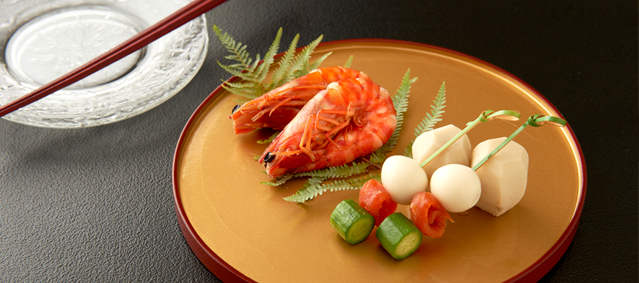
Have you ever thought: How can I eat this dish without making a mess?
Many of us at one time or another have had to cope with uneasiness — Am I eating this the right way? — while eating in front of others. To assuage this anxiety, we turned to food researcher Kubo Kanako for this article to get advice on graceful and cultured dining etiquette.
At somewhat formal dinners and other occasions, we want to enjoy our meals deliciously and with class. But this raises many questions: How can I eat this dish without looking clumsy and what parts can I eat? In this article, we’ll examine certain problematic dishes and teach you the tricks to eat them with flair.
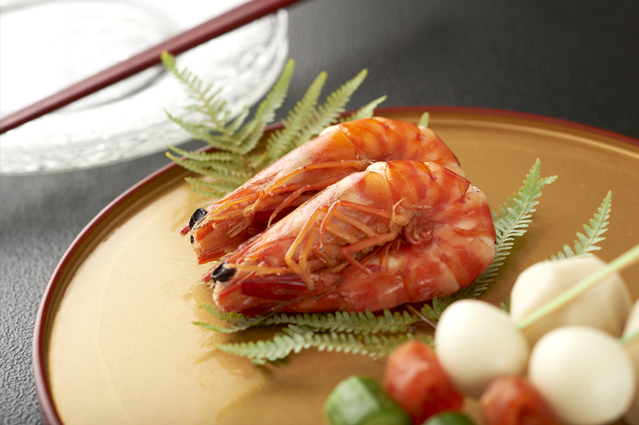
One colorful dish served often at high-class ryotei Japanese restaurants and other fine dining establishments is shrimp. Shrimp, however, poses the problem of how to eat it gracefully, as it is easy to get your hands dirty. More to the point, how should you remove the head, is it okay to peel the shell with your hands, and can you eat the tip of the tail? Kubo kindly gave us pointers on the steps to eating shrimp.
“With boiled shrimp, you can eat everything but the hard shell at the head and tail. And if you are in a situation where it might be embarrassing to peel off every bit of the shell, you can always resort to eating the shell if it’s soft.” And when you don’t want to get your hands dirty while peeling the shell, it’s a good idea to use a kaishi paper sheet or paper napkin.
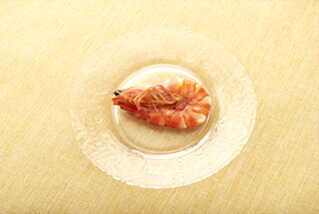
1. Arrange the shrimp on your plate so the head is facing left (if you are right-handed).
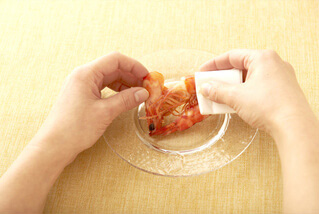
2. Grasp the head shell with your fingers and pull the shell off.
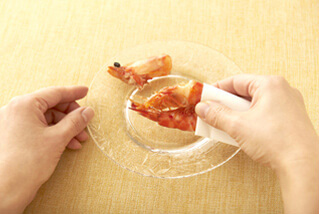
3. Although some people remove the entire head, try removing just the shell, as the meat and brains inside the shell are delicious.

4. Once you have removed the head shell, the rest of the shell is soft apart from the very end of the tail, so you can eat everything.
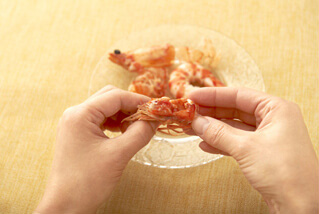
5. If you peel off the entire shell, it’s fine to savor the delicious meat and brains inside the head shell.
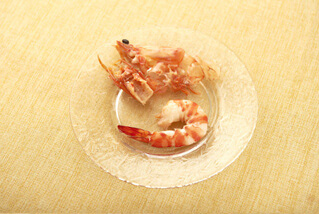
6. Collect the peeled shells together in one place.
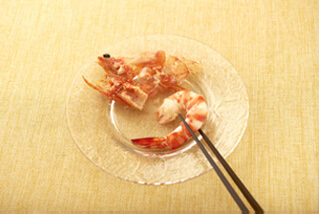
7. Hold the peeled shrimp in your chopsticks to eat. Although you use your hands to peel off the shell, use chopsticks instead of your hand to bring it to your mouth.
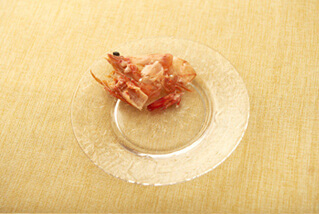
8. Place the tail section together with the peeled shells.
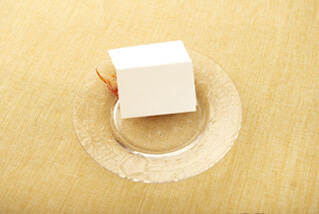
9. When you are done, cover the scraps with a kaishi sheet to leave your plate looking attractive.

Food on skewers are a popular item served on many occasions. But if asked how to eat these dishes properly, it’s likely only a few people could answer with confidence. Kubo gave us easy-to-follow instructions. “Instead of holding the skewer in your right hand and bringing it directly to your mouth, hold it in your left hand and remove the pieces with your chopsticks first. Then you can eat the pieces more easily and gracefully.”
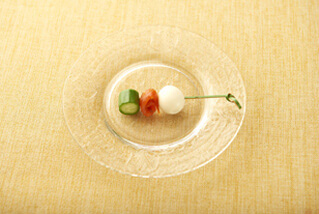
1. With Japanese cuisine, the free end of the skewer always points right.
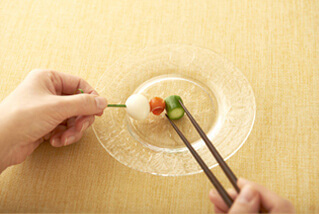
2. Grab the end of the skewer with your left hand, turn it to face to the left, and pull the pieces off the skewer with your chopsticks.
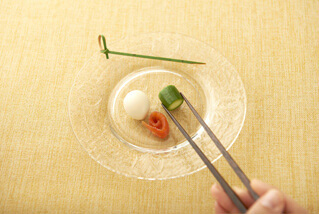
3. Once all the pieces are removed from the skewer, eat each piece with your chopsticks.
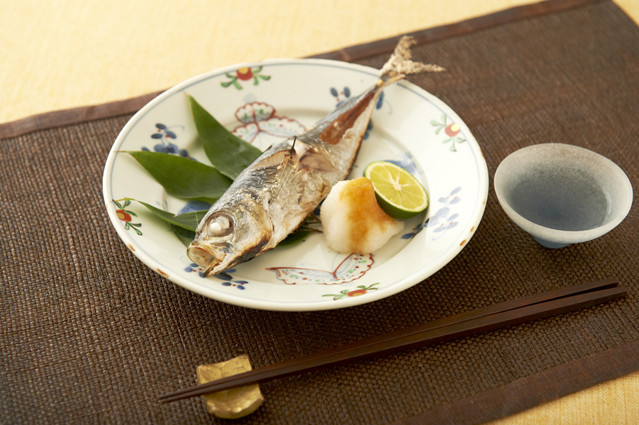
Another challenge for many is how to eat a grilled whole fish without making a mess. Part of the problem may be that people have few chances to learn how to eat grilled fish properly. A recent concern is that many kids dislike fish nowadays. Some reasons for this are that fish are hard to eat and contain bones. In order to eat grilled fish in a refined manner in front of others, and to teach kids how to eat fish properly, we asked Kubo for the best way to eat grilled whole fish.
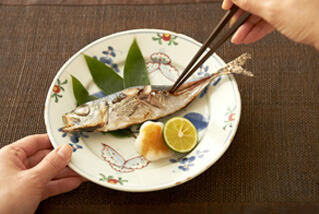
1. Slice the fish open by inserting your chopsticks at the shoulder behind the head and cutting along the backbone.
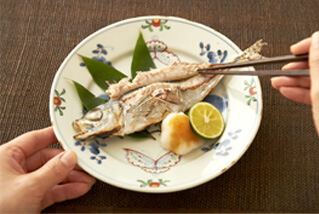
2. Fold back the dorsal meat and remove it from the bone. Eat the removed meat.
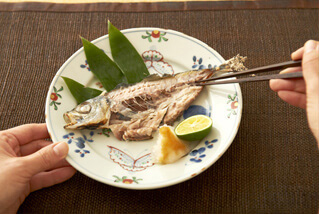
3. Next, remove and eat the ventral meat.
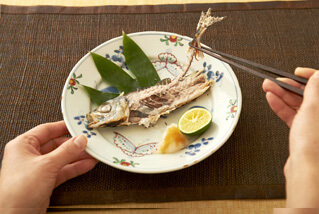
4. After eating all the meat on the front side, remove the back bone. Begin by lifting the bone from the tail end with your chopsticks.
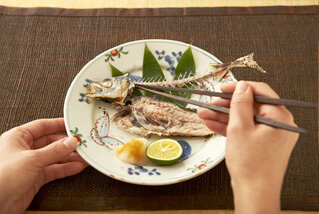
5. Cut the skin that connects the bottom side meat to the head and lift off the head and backbone.
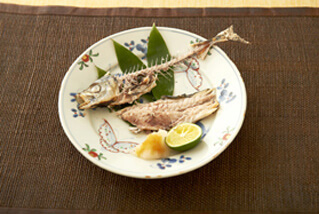
6. Remove any fine bones remaining in the meat.
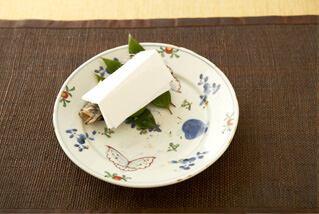
7. Gather the bones and sudachi citrus rinds in one place. As with shrimp shells, cover the remains with a kaishi sheet for an elegant look.
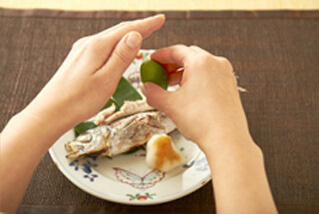
Extra point: When garnishing the fish with sudachi or lemon, squeeze while covering with your hand to stop any errant juice sprays.
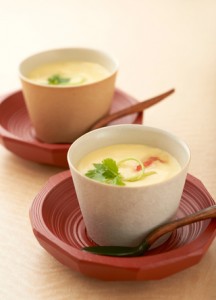
Chawanmushi [steamed egg custard] is often served at ryotei and other establishments as a substitute for soup. The custard’s consistency varies from restaurant to restaurant, and it is often soft and soupy. “Chawanmushi is sometimes too hot to hold the bowl directly with your hand. And when eating it with a spoon, it’s easy to make the mistake of using your hand as a kind of plate to catch drips. To eat chawanmushi gracefully, you need to lift the bowl with your hand. If it is too hot, use a kaishi sheet or a saucer to raise it up to eat,” Kubo advises.
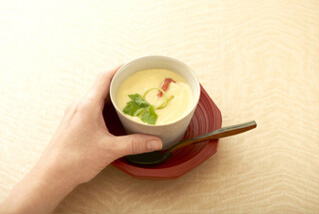
Don’t immediately try to pick up the bowl, as it may be very hot.
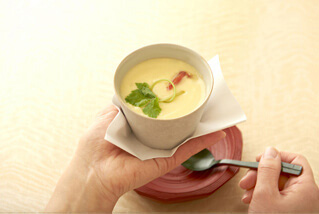
If the bowl is too hot to pick up with your hand, use a kaishi sheet or a plain white handkerchief.
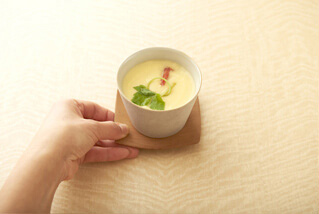
Don’t try to lift an unsteady saucer.
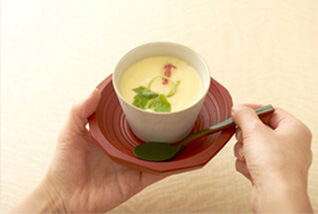
If the saucer is stable, you can hold the saucer while you eat.
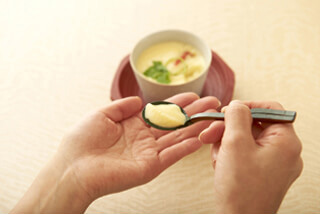
Don’t leave the bowl on the table and use your hand to catch drips.
In this article, Kubo kindly taught us the steps to eat problematic dishes properly. Once you have this etiquette down, you will be able eat without feeling self-conscious and better enjoy the flavors of the dishes. Try these methods for yourself and eat with grace and refinement.
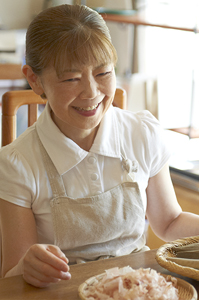
Culinary Researcher
Culinary Researcher
Growing increasingly interested in cooking, Kubo Kanako studied at the long-established Kyoto ryotei (high-class Japanese restaurant) Tankuma Kitamise from the time she was a high school student. After graduating from the Department of English at Doshisha University, she entered the Tsuji Culinary Institute, where she obtained chef’s and fugu (puffer fish) cooking licenses. Following a stint in the Tsuji Culinary Institute’s publications arm, she edited cook books at a publishing house in Tokyo, before going independent.
Today, Kubo is actively involved in a variety of culinary-related endeavors, including culinary production, styling, restaurant menu development, table decorating, editing and more.
She is the author of several works in Japanese, including Utsukushii morituske no kihon [Basics of Beautiful Plating] (Seibido Shuppan), Utsukushii ichiju nisai: “Oishii” to “kirei” in ha wake ga aru [Beautiful Soup and Two Dishes: There are Reasons for “Deliciousness” and “Beauty”] (Kawade Shobo Shinsha), Kichinto, yasai no kobachi chotto shita kotsu de “mō ippin” ga gutto oishikunaru! [Small Vegetable Side Dishes: Little Tips that Make That Extra Something So Much More Delicious] (Kawade Shobo Shinsha), Kichinto, oishii mukashinagara no ryōri [Delicious Old-Time Cooking] and Shun no aji techō aki to fuyu [Seasonal Flavor Handbook: Fall and Winter] (both Seibido Shuppan)